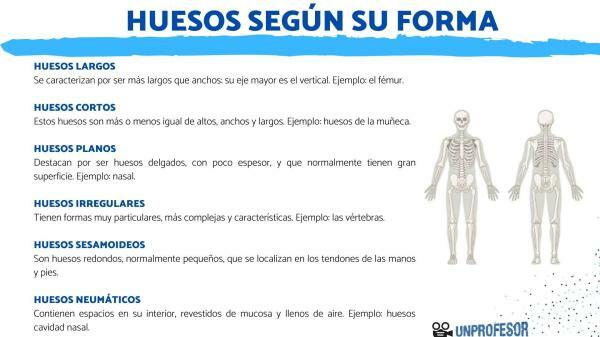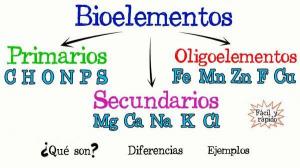Bones of the human BODY and their names

In order for living beings (including humans) to develop on our planet, they need a resistant structure that provides support and protection to the body. This role is performed by the osseous system. In this new lesson from a TEACHER we will talk about the bones of the human body and their names. Read us below to learn more about them!
The osseous system The skeletal system is the complex and resistant structure of bones that forms our skeleton. This structure is arranged throughout the body in a certain order and provides support to our body and the necessary protection to our internal organs.
It forms the musculoskeletal system of the human body, where it acts together with the muscular system and the joints to give us the support and movement necessary to develop our lives.
The skeletal system is made up of strong and rigid parts that connect to each other forming reinforced joints of cartilage, which is a rigid material, more elastic than bone and less resistant. The matrix that forms the
bone is mainly made up of crystals of phosphate and calcium salts that harden in a process known as bone mineralization.In addition to these crystals, there are also other elements, the most abundant of which is collagen. Embedded in this matrix are the living cells of the tissue, osteoblasts, osteocytes and osteoclasts, which are responsible for the formation, destruction and metabolism of bone.
The skeletal system is made up of a total of 206 bones. (without taking into account the teeth), representing 12% of the total body weight. The bones join together to form a continuous structure, except for one isolated bone in the lower neck called the hyoid bone.
To allow the bones to articulate with each other and serve as a cushion between each other, there are other elements such as tendons, ligaments and cartilage, which also keeps them fixed in place and covered by musculature, which allows them to support their own weight.
Thanks to its hardness and resistance, bones are the last thing to break down in the body, lasting much longer than other structures of the body.
Not all the bones that make up the human body are the same, but are usually classified into different types according to their shape. These types are:
long bones
These are elongated bones, straight, cylindrical and are formed by two ends known as epiphyses. The function of the long bones is to support weights and facilitate movements, for this reason they are typical bones of the limbs, for example we have those of the lower limbs such as the tibia or fibula and the upper ones such as the humerus or the ulna.
flat bones
These are flattened bones, like shields, which allow them to carry out their main function, which is to protect internal organs and soft structures. They are important in the bony structure of the head (occipital bone, temporal bone, etc.), the rib cage (sternum and ribs), and the pelvic structures (pelvis, ilium and ischium). Another of its functions is to allow the union of large groups of muscles.
short bones
These bones are practically the same length as width, with small, flattened and more or less cylindrical in shape. They provide stability and some mobility in the joints of the wrist, as in the carpal bone, and the ankle, as in the calcaneus.
sesamoid bones
The sesamoid bones They are small, round bones found in the tendons of joints. Its function is to protect the tendons from stress and deterioration and to increase bone leverage and allow movement. They are found in joints such as the hands, feet, and knee. An example of a sesamoid bone is the kneecap, sometimes known as the patella.
irregular bones
The irregular bones They are highly variable bones in shape and structure, so they do not fall into any other category. They usually have complex shapes, which helps them in their function of protecting internal organs. Examples of irregular bones are the vertebrae in the spinal column, which protect the spinal cord, or the irregular bones in the pelvis, which protect the pelvic cavity.

Bones are distributed throughout the body, protecting a large segment of the human body. The most covered is the head, both by the bones of the skull and by those of the face and the thorax is also well protected by the ribs, sternum, shoulder blades or spine.
Then there are the bones of the hip and those of the limbs, both lower and upper. However, there is a portion that does not have bones and it is the abdomen, where the abdominal viscera are accommodated, such as the pancreas, liver, intestines or stomach.
Some of the bones in the human body and their names are as follows. ç
Head (28 bones) and neck (1 bone)
They are divided into 8 flat bones (some pairs) of the skull, with great hardness, as they protect the brain, such as the frontal, parietal, temporal, occipital, sphenoid or ethmoid, and 20 facial bones and 14 facial bones (some in pairs) such as the nasal, upper and lower axillary, zygomatic, turbinates, vomer, palatines or tear ducts Only the hyoid bone is found in the neck.
Vertebral column (26 bones)
It is made up of vertebrae distributed by segments, which protect the spinal cord and are the cervical, dorsal, lumbar vertebrae, the sacrum and the coccyx.
Thorax (25 bones)
They protect the thoracic organs and allow the inflation of the lungs and are the sternum and the ribs.
Shoulder girdle (4 bones) and pelvic girdle (2 bones)
In the shoulder girdle we have the clavicles and shoulder blades and in the pelvic we have the pelvic bones, which are the largest bones in the human body, especially in women.
Upper limbs (60 bones) and lower limbs (60 bones)
In the extremities is where there is a greater amount of bones, since many of them are small bones that help to give mobility and stability to the joints. In the upper limbs we have the humerus, radius, ulna, carpal bones, metacarpals, and phalanges. In the lower limbs are the femur, tibia, fibula, tarsal bones, metatarsals, and phalanges.



